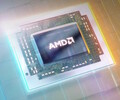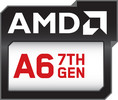AMD A9-9425 vs AMD A6-9220e vs AMD A6-9225
AMD A9-9425
► remove from comparison
The AMD A9-9425 is an entry-level chip from the Stoney-Ridge APU series for notebooks (7th APU generation), which was announced mid 2018. Compared to the one year older A9-9420, the 9425 has a 100 MHz higher CPU clock speed (base and boost) as well as a marginally faster iGPU. It integrates two CPU cores (one Excavator module with 2 integer and on FP unit) clocked at 3.1 GHz to 3.7 GHz. It also includes a Radeon R5 GPU with 192 shaders at up to 900 MHz as well as a single-channel DDR4-2133 memory controller, H.265 video decoder and chipset with all I/O ports.
Architecture
Stoney Ridge is the successor of the Carrizo architecture and the design is almost identical. Thanks to optimized manufacturing processes and more aggressive Boost behavior, however, the clocks are a bit higher at the same power consumption. The memory controller now also supports DDR4-RAM, in this case up to 2133 MHz. Stoney Ridge is the designation for the smaller dual-core and single-core chip, while Bristol Ridge is the bigger quad-core chip with dual-channel memory controller. More technical details are available in the following articles:
Performance
The average 9425 in our database proves to be a rather slow CPU, its multi-thread benchmark scores only just matching those of the Intel Core i3-4012Y. Much like it is with N-class Intel chips, expect a system built around an A9-9425 to perform poorly in all but the most basic tasks.
Graphics
The integrated Radeon R5 (Stoney Ridge) GPU has 192 active shader units (3 compute cores) clocked at up to 900 MHz. More details about the GPU are available in the linked articles above.
Power consumption
This A9 series chip has a default TDP of 15 W. Laptop makers are free to reduce that somewhat with 10 W being the minimum AMD-recommended value; clock speeds and performance will be reduced as a result. By going for the lowest value, it will be possible to build a passively cooled system around the APU.
Last but not the least, the AMD A9-9425 is manufactured on a 28 nm process for very, very low energy efficiency, as of 2022.
AMD A6-9220e
► remove from comparison
The AMD A6-9220e is an entry-level chip from the Stoney-Ridge APU series for notebooks (7th APU generation), which was announced mid 2017. The 9220e is an entry-level Stoney Ridge processor (dual-core version of Bristol Ridge) and integrates two CPU cores (one Excavator module with 2 integer and on FP unit) clocked between 1.6 - 2.4 GHz. It also includes a Radeon R4 GPU, probably with 192 shaders at 600 MHz, as well as a single-channel DDR4-2133 memory controller, H.265 video engine and chipset with all I/O ports. Compared to the similar named A6-9220 the 9220e is significantly slower clocked (2.5 - 2.9 GHz) including the GPU (600 versus 655 MHz) and can be passively cooled thanks to the TDP of 6W.
Architecture
Stoney Ridge is the successor of the Carrizo architecture and the design is almost identical. Thanks to optimized manufacturing processes and more aggressive Boost behavior, however, the clocks are a bit higher at the same power consumption. The memory controller now also supports DDR4-RAM, in this case up to 2133 MHz. Stoney Ridge is the designation for the smaller dual-core and single-core chip, while Bristol Ridge is the bigger quad-core chip with dual-channel memory controller. More technical details are available in the following articles:
Performance
Because of the significantly lower clock speed, the A6-9220e is noticeably slower than the A6-9220. In the Cinebench R15 Multi benchmark the 9220 reaches 38% higher scores, in the single thread test its more than twice as fast (219% versus the 9220 in the HP 255 G6). Compared to Intel CPUs, the A6-9220e is on par with the old Celeron N2820 in Cinebench (single and multi core). Therefore, the CPU is placed in the lowest segment (performance wise) and only suited for light tasks and light multitasking.
Graphics Card
The integrated Radeon R4 (Stoney Ridge) GPU is probably similar to the R5 with 192 active shader units (3 compute cores), but a reduced clock of just 655 instead of 800 MHz. More details about the GPU are available in the linked articles above.
Power Consumption
AMD specifies the TDP of the A6-9220e with 6 Watts and therefore significantly below the 15 W of the A6-9220. This means the APU can be passively cooled and is a good choice for thin and light notebooks.
AMD A6-9225
► remove from comparison
The AMD A6-9225 is an entry-level chip from the Stoney-Ridge APU series for notebooks (7th APU generation), which was announced mid 2018. Compared to the one year older A4-9220, the A4-9225 has a 200 MHz higher CPU Boost clock but a slower iGPU. It integrates two CPU cores (one Excavator module with 2 integer and one FP unit) clocked at 2.6 GHz to 3.1 GHz. It also includes a Radeon R4 GPU, probably with 192 shaders at up to 686 MHz, as well as a single-channel DDR4-2133 memory controller, H.265 video decoder and chipset with all I/O ports.
Architecture
Stoney Ridge is the successor to the Carrizo architecture and the design is almost identical. Thanks to optimized manufacturing processes and more aggressive Boost behavior, however, the clocks are a bit higher at the same power consumption. The memory controller now also supports DDR4-RAM, in this case up to 2133 MHz. Stoney Ridge is the designation for the smaller dual-core and single-core chip, while Bristol Ridge is the bigger quad-core chip with dual-channel memory controller. More technical details are available in the following articles:
Performance
The average 9225 in our database proves to be a very, very, very slow processor, its multi-thread benchmark scores only just matching those of the Core 2 Duo P8600 (a dual-core CPU that saw the light of day in 2008). This is a record-breakingly poor performance and a warning to anyone looking to purchase a system built around this specific A6 series CPU.
Graphics
The integrated Radeon R4 (Stoney Ridge) GPU is probably similar to the R5 with 192 active shader units (3 compute cores), but a reduced clock of just 686 MHz instead of 800 MHz. More details about the GPU are available in the linked articles above.
Power consumption
This AMD A6 series chip has a default TDP (also known as the long-term power limit) of 15 W. Laptop makers are allowed to reduce that value somewhat, 10 W being the lower limit, with clock speeds and performance changing accordingly as a result. By going for the lowest value, it will be possible to build a passively cooled system around the APU.
Last but not the least, the A6-9225 is built with a 28 nm process leading to very, very low energy efficiency, as of 2022.
| Model | AMD A9-9425 | AMD A6-9220e | AMD A6-9225 | ||||||||||||||||||||||||||||||||||||||||||||||||||||||||||||||||||||||||||||||||||||||||||||||||||||||||||||||||||||||||||||||||||||||||||||||||||||||||||||
| Series | AMD Bristol Ridge | AMD Bristol Ridge | AMD Bristol Ridge | ||||||||||||||||||||||||||||||||||||||||||||||||||||||||||||||||||||||||||||||||||||||||||||||||||||||||||||||||||||||||||||||||||||||||||||||||||||||||||||
| Codename | Stoney Ridge | Stoney Ridge | Stoney Ridge | ||||||||||||||||||||||||||||||||||||||||||||||||||||||||||||||||||||||||||||||||||||||||||||||||||||||||||||||||||||||||||||||||||||||||||||||||||||||||||||
| Series: Bristol Ridge Stoney Ridge |
|
|
| ||||||||||||||||||||||||||||||||||||||||||||||||||||||||||||||||||||||||||||||||||||||||||||||||||||||||||||||||||||||||||||||||||||||||||||||||||||||||||||
| Clock | 3100 - 3700 MHz | 1600 - 2400 MHz | 2600 - 3100 MHz | ||||||||||||||||||||||||||||||||||||||||||||||||||||||||||||||||||||||||||||||||||||||||||||||||||||||||||||||||||||||||||||||||||||||||||||||||||||||||||||
| L2 Cache | 1 MB | 1 MB | 1 MB | ||||||||||||||||||||||||||||||||||||||||||||||||||||||||||||||||||||||||||||||||||||||||||||||||||||||||||||||||||||||||||||||||||||||||||||||||||||||||||||
| Cores / Threads | 2 / 2 | 2 / 2 | 2 / 2 | ||||||||||||||||||||||||||||||||||||||||||||||||||||||||||||||||||||||||||||||||||||||||||||||||||||||||||||||||||||||||||||||||||||||||||||||||||||||||||||
| TDP | 15 Watt | 6 Watt | 15 Watt | ||||||||||||||||||||||||||||||||||||||||||||||||||||||||||||||||||||||||||||||||||||||||||||||||||||||||||||||||||||||||||||||||||||||||||||||||||||||||||||
| Transistors | 1200 Million | 1200 Million | 1200 Million | ||||||||||||||||||||||||||||||||||||||||||||||||||||||||||||||||||||||||||||||||||||||||||||||||||||||||||||||||||||||||||||||||||||||||||||||||||||||||||||
| Technology | 28 nm | 28 nm | 28 nm | ||||||||||||||||||||||||||||||||||||||||||||||||||||||||||||||||||||||||||||||||||||||||||||||||||||||||||||||||||||||||||||||||||||||||||||||||||||||||||||
| Die Size | 124.5 mm2 | 124.5 mm2 | 124.5 mm2 | ||||||||||||||||||||||||||||||||||||||||||||||||||||||||||||||||||||||||||||||||||||||||||||||||||||||||||||||||||||||||||||||||||||||||||||||||||||||||||||
| max. Temp. | 90 °C | 90 °C | 90 °C | ||||||||||||||||||||||||||||||||||||||||||||||||||||||||||||||||||||||||||||||||||||||||||||||||||||||||||||||||||||||||||||||||||||||||||||||||||||||||||||
| Features | DDR4-2133 RAM (1 channel), PCIe 3, MMX, SSE, SSE2, SSE3, SSSE3, SSE4A, SSE4.1, SSE4.2, AVX, AVX2, BMI2, ABM, TBM, FMA4, XOP, SMEP, CPB, AES-NI, RDRAND | Single-Channel DDR4-2133, Virtualization, | DDR4-2133 RAM (1 channel), PCIe 3, MMX, SSE, SSE2, SSE3, SSSE3, SSE4A, SSE4.1, SSE4.2, AVX, AVX2, BMI2, ABM, TBM, FMA4, XOP, SMEP, CPB, AES-NI, RDRAND | ||||||||||||||||||||||||||||||||||||||||||||||||||||||||||||||||||||||||||||||||||||||||||||||||||||||||||||||||||||||||||||||||||||||||||||||||||||||||||||
| iGPU | AMD Radeon R5 (Stoney Ridge) ( - 900 MHz) | AMD Radeon R4 (Stoney Ridge) ( - 600 MHz) | AMD Radeon R4 (Stoney Ridge) ( - 686 MHz) | ||||||||||||||||||||||||||||||||||||||||||||||||||||||||||||||||||||||||||||||||||||||||||||||||||||||||||||||||||||||||||||||||||||||||||||||||||||||||||||
| Architecture | x86 | x86 | x86 | ||||||||||||||||||||||||||||||||||||||||||||||||||||||||||||||||||||||||||||||||||||||||||||||||||||||||||||||||||||||||||||||||||||||||||||||||||||||||||||
| Announced | |||||||||||||||||||||||||||||||||||||||||||||||||||||||||||||||||||||||||||||||||||||||||||||||||||||||||||||||||||||||||||||||||||||||||||||||||||||||||||||||
| Manufacturer | www.amd.com | www.amd.com | |||||||||||||||||||||||||||||||||||||||||||||||||||||||||||||||||||||||||||||||||||||||||||||||||||||||||||||||||||||||||||||||||||||||||||||||||||||||||||||
| L1 Cache | 160 KB | 160 KB | |||||||||||||||||||||||||||||||||||||||||||||||||||||||||||||||||||||||||||||||||||||||||||||||||||||||||||||||||||||||||||||||||||||||||||||||||||||||||||||
| Socket | BGA |


 Deutsch
Deutsch English
English Español
Español Français
Français Italiano
Italiano Nederlands
Nederlands Polski
Polski Português
Português Русский
Русский Türkçe
Türkçe Svenska
Svenska Chinese
Chinese Magyar
Magyar
